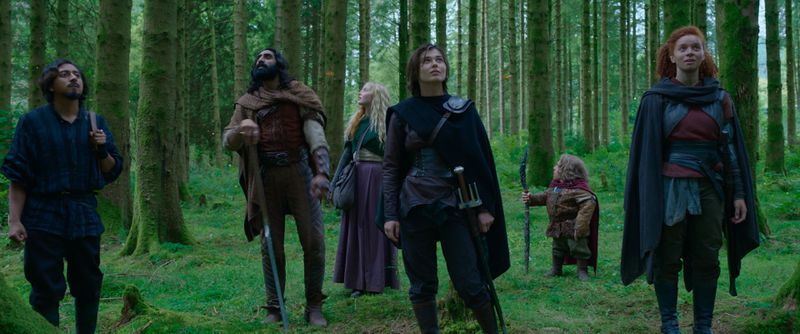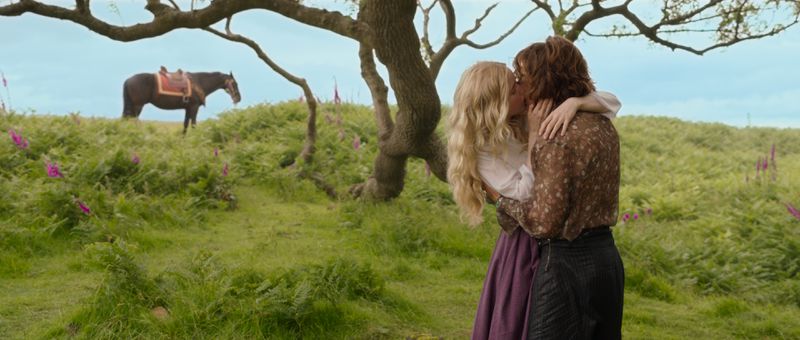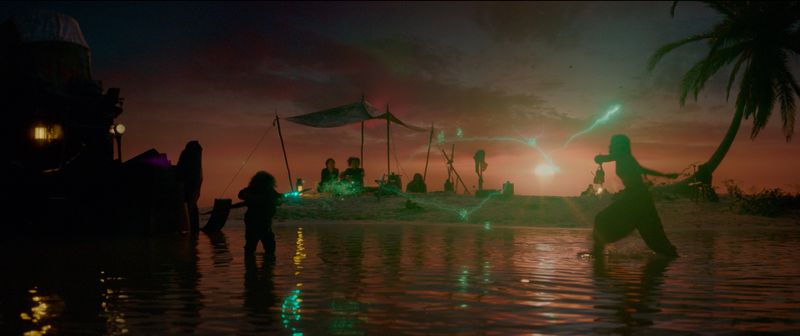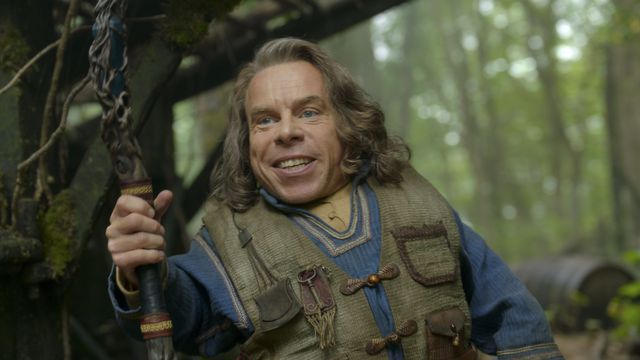A princess and a lady knight never got together in George Lucas’ original, but for Jonathan Kasdan, it was an obvious next step
Ron Howard and George Lucas’ 1988 fantasy epic Willow aimed to do for fantasy cinema what Star Wars had done for science fiction. While it didn’t quite live up to that lofty promise, Willow remains a cult favorite, a pillar of the crop of 1980s fantasy films that delighted adults and both terrified and enthralled children.
Among those children was producer Jonathan Kasdan, who brings a sequel TV series of the same name to Disney Plus, with a two-episode premiere on Nov. 30. Warwick Davis (Return of the Jedi, Harry Potter and the Sorcerer’s Stone) returns as the eponymous aspiring sorcerer, as does a smattering of cast from the original film. But the series boasts a new main cast, to suit the blend of ’80s modern YA fantasy that Kasdan and his collaborators have brought to bear.
This time, Willow is accompanied by a whole ensemble squad of mostly teenagers, each pulling and pushing against fantasy tropes that will be excitingly familiar to an audience in an era where D&D is mainstream and YA fiction is full of plucky heroes and heroines. The role of Elora Danan, the legendary infant Chosen One who was destined to save the world, has been kept under tight wraps, but nevertheless she casts a long shadow over the series and its stars.
Willow’s two mains are Kit and Dove, both young women who wrestle with the legacy of Elora Danan. But Kit’s own bildungsroman may come to overshadow Dove’s in conversations about the show, as a good part of her journey is realizing that she’s in mutual love with her best friend. In a long overdue and welcome development for fantasy cinema, television, and the Disney corporation itself, Kit (a self-centered tomboy princess who spends most of the series dressed like the Dread Pirate Roberts) and Jade (an orphan girl who wants to become her country’s first female knight) are as though someone took every tomboy fantasy heroine in the YA literature canon, tossed them in a blender, and flipped a big mad scientist lever from SUBTEXT to TEXT.
Polygon sat down with Kasdan to talk first and foremost about being the first true franchise on Disney Plus to really center a queer story — and also about weird movies from the 1980s, the road from there to modern YA fantasy, and the flip side of the fantasy hero coin: truly terrible villains.

Image: Lucasfilm
Polygon: How did a queer relationship come to be the core of this show? When did it enter the process and was there any pushback?
Jonathan Kasdan: There was no pushback. What’s interesting is — I hope and I believe we’re at a moment where you’re going to see a paradigm shift in that. And hopefully, the way that it’s gonna happen is that these kinds of [queer] stories, particularly like this one, that were just organic to the narrative we were telling, find their way in, and it becomes less of a surprising and unusual thing to see.
Because it’s a part of the landscape of the world around us, just like the diversity elements of casting. If you look at the original Willow, by no fault of anyone, it’s not very diverse. And as we enter 2022, the world has changed, in the way we’re absorbing entertainment, and the faces we’re reflecting in entertainment have expanded enormously, and we hope the show can be growing as the world grows. Just as, frankly, the movie was.
One thing that I love about the movie is that you have this very classical fantasy, but at the heart of it, you have this very contemporary Val Kilmer character who has a sound that it’s unlike any other ’80s fantasy character that had ever been, and it was important to us to keep alive that spirit of moving the genre into a contemporary sound.
The show really does feel like a fusion of the oddball fantasy films of the ’80s — Willow, Labyrinth, The Last Unicorn, The Neverending Story — with like a modern YA sensibility where characters spend as much time fighting baddies as they spend talking to each other about their emotions.
Dead on. Particularly when you add The Last Unicorn in there, a movie I adore and for a lot of kids was a big fantasy film and a touchstone. But I came up working on shows like Freaks and Geeks and Dawson’s Creek and writing angsty high school movies and such. So those things were a well-blended world.

Image: Lucasfilm
I discovered when I started into this, as you knew probably long before I, that fantasy and YA had a real intersection. There was a huge world of these stories — and it’s not surprising when you think about it, because themes of power and danger and outside evil and inside evil are inherent in all of our stories of coming of age. It made sense that this is a subgenre that is perennial, because it’s a way of externalizing what’s a very internal struggle for most young people.
It’s so interesting what people latch on to from that era that becomes a touchstone for them. My buddies were flabbergasted that I hadn’t watched Willow, and then halfway through our watch I found out that they’d never seen The Last Unicorn.
I’ll tell you my embarrassing one, which is that in the middle of writing the first season of this show, in the writers room, it came out that I had not seen Labyrinth, which was a very embarrassing thing for a guy writing a fantasy show. So I immediately rushed home and fell in love with Labyrinth, which has a million brilliant moments and ideas in it. We’ve all got our little gaps. Willow is a good one for you to fill in, and hopefully the movie holds up enough so that people are at least curious about it.
We’ve talked about a lot of ’80s film influences. Are there any particular YA fantasy works that influenced your thinking as well?
Harry Potter was a huge influence here, and I’ll tell you why: The very first Harry Potter book opens with a baby abandoned on a doorstep of someone who doesn’t want it. And when I read it for the first time, I’m certain I thought of Willow, I thought, Where have I seen this story before? I’ve seen it in the Bible. I’ve seen it in Willow. And now I’m seeing it in Harry Potter.

Image: Lucasfilm
What J.K. Rowling proceeded to do over those books in terms of linking magic and adolescence in this incredibly complicated way felt like a story that I’d be interested in telling. And certainly a reason to do something more with Elora Danan as well.
One of the things that I appreciate most in that glut of weird ’80s fantasy for kids is how willing it was to just let kids be scared.
It’s so important. It’s so critical to my matriculation and education as a storyteller, and as an imaginative human being, was that these movies had this stuff in it that was really sort of disturbing, and stuck with you for your whole life and formed the iconography of good and evil for you. I worry sometimes, I see it with my niece and my nephews, that they’re exposed to so much now, and we’re so bombarded with content at the moment, I wonder if they have that same resonating feeling about what’s scary.
For me, the example that comes to mind most specifically is in The Neverending Story, when the horse is stuck in the mud and we get the sense the horse is going to die and you can see Atreyu pulling at it, and his agony is totally palpable. And for anyone who saw that, as a kid, they never forgot it for as long as they live — and never will, you know. So I hope those moments exist in the stories that we’re telling, and I think the more of them, the better. Because it’s important for kids to not be afraid to be sad, and frightened, and let that be part of growing up, you know, because it absolutely will be.
Speaking of iconography of good and evil, our heroes in the show spend most of their time facing off against the underlings of the Crone, who serves the Wyrm, both of whom remain very mysterious. What does the Crone represent to you?
The Crone does not even represent the final layer of this darkness; she’s the emissary of something much greater and darker and more powerful. What I’m interested in, related to the question you’ve been asking, is what kind of villain and what kind of antagonist really is worthy of these stories these days. What we arrived at, and what I’ve always been interested in, are these cosmic villains, these things where their deepest power, and their most insidious evil, is that they give us some glimpse of our total insignificance in the universe. And that’s the truly terrifying final reveal.
It’s a Lovecraftian trope, and it comes out of those sort of stories in a lot of ways. But I loved the idea that to whomever this final villain is, we are ants barely playing on the cement, and he needs to only reach out and crush us. [The Crone is] the spokesperson of that voice and ends up being really representative to me of, weirdly enough, more of a worldview and of a philosophical view, than she is an out and out villain. There’s nihilism at the core of the Crone that I really wanted to explore. And I think that even after her story ends, the influence of that philosophical point of view is going to leave a permanent impact on our characters.

